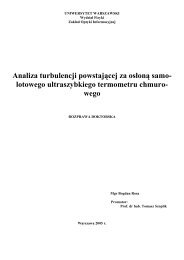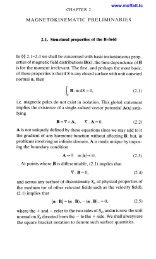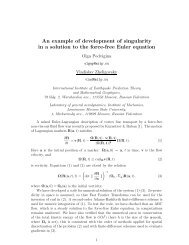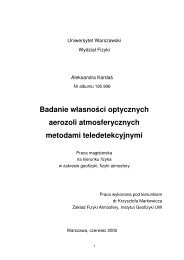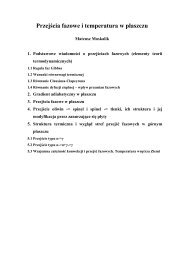A similarity solution for viscous source flow on a vertical plane
A similarity solution for viscous source flow on a vertical plane
A similarity solution for viscous source flow on a vertical plane
You also want an ePaper? Increase the reach of your titles
YUMPU automatically turns print PDFs into web optimized ePapers that Google loves.
5<br />
8<br />
42 B. R. Duffy and H. K. Moffatt<br />
The governing equati<strong>on</strong>s (2.2) and (2.4) involve the two length scales<br />
L <br />
(γρg sin α)/ and L <br />
(µQρg sin α)/ (2.14)<br />
(which are prescribed quantities). There is there<str<strong>on</strong>g>for</str<strong>on</strong>g>e some freedom in choosing n<strong>on</strong>dimensi<strong>on</strong>al<br />
variables. With the scheme<br />
x kL x , y kL y , y e<br />
kL y e , h k L h 104, c (kL )/ c , (2.15)<br />
<br />
where k N/(L L )/, the <str<strong>on</strong>g>soluti<strong>on</strong></str<strong>on</strong>g> may be written in the <str<strong>on</strong>g>for</str<strong>on</strong>g>m<br />
<br />
h (x , y ) <br />
G(η)<br />
x /[P(λ)]/ ,<br />
η y , y<br />
y e P(λ) x / , (2.16)<br />
e<br />
with G(η) and P(λ) as in (2.6) and (2.9). The <str<strong>on</strong>g>soluti<strong>on</strong></str<strong>on</strong>g> involves <strong>on</strong>e free parameter, here<br />
taken to be λ; thus (2.16) represents a family of <str<strong>on</strong>g>soluti<strong>on</strong></str<strong>on</strong>g>s, with parameter λ.<br />
The analysis is valid <str<strong>on</strong>g>for</str<strong>on</strong>g> both c 0 and c 0, provided that y e<br />
and h are positive; this<br />
means that cx 0, that cG 0, and that the η-domain must be chosen such that G(η) is<br />
of <strong>on</strong>e sign.<br />
3 Interpretati<strong>on</strong> of the <str<strong>on</strong>g>soluti<strong>on</strong></str<strong>on</strong>g><br />
(i) For all cases except case (c) we take η 1 <str<strong>on</strong>g>for</str<strong>on</strong>g> the moment. Case (c) is different in that<br />
the corresp<strong>on</strong>ding interval <str<strong>on</strong>g>for</str<strong>on</strong>g> η is η κ, where κ (λ1)/ (with 1 λ 2); thus, <str<strong>on</strong>g>for</str<strong>on</strong>g><br />
example, the integrati<strong>on</strong> limits in equati<strong>on</strong> (2.7) <str<strong>on</strong>g>for</str<strong>on</strong>g> case (c) should be κ, rather than 1.<br />
However, <strong>on</strong>e can show easily that under the change of variables<br />
η η*(λ*1)/, (λ1)(λ*1) 1, c c*(λ*1)/, y e<br />
(λ*1)/ y e<br />
,<br />
the <str<strong>on</strong>g>soluti<strong>on</strong></str<strong>on</strong>g> <str<strong>on</strong>g>for</str<strong>on</strong>g> case (c) becomes the same as that <str<strong>on</strong>g>for</str<strong>on</strong>g> case (a), with η, λ, c and y e<br />
replaced<br />
by η*, λ*, c* and y e<br />
, and with η* 1. This means that case (c) can be subsumed into case<br />
(a), and need not be treated separately.<br />
In all cases, then, the c<strong>on</strong>tact angle β(x) atyy e<br />
and the centre-line depth h <br />
(x) of the<br />
liquid are given approximately by<br />
tan β h (λ2) cρg sin α<br />
<br />
y y=ye<br />
52γ(cx)/<br />
(3.1)<br />
and<br />
h <br />
h(x,0)<br />
(λ1) cρg sin α<br />
. (3.2)<br />
104γ(cx)/<br />
Note that in this <str<strong>on</strong>g>soluti<strong>on</strong></str<strong>on</strong>g> β varies round the c<strong>on</strong>tact line (except when λ 2), and cannot<br />
be prescribed. (Smith’s <str<strong>on</strong>g>soluti<strong>on</strong></str<strong>on</strong>g> has a similar feature.) It is expected that (3.1) can hold <strong>on</strong>ly<br />
where β r<br />
β β a<br />
.<br />
The c<strong>on</strong>diti<strong>on</strong> Q 0 requires that λ λ <br />
if c 0 and λ λ <br />
if c 0. In additi<strong>on</strong> the<br />
c<strong>on</strong>diti<strong>on</strong>s h <br />
0 and 0 tan β ( 1) require that<br />
either I: c 0, x 0, λ 2, G(η) 0 (cases (a), (b)),<br />
or II: c 0, x 0, λ 1, G(η) 0 (cases (d), (e), (f))<br />
(both of which give Q 0 and h(x, y) 0, as required).<br />
6<br />
7<br />
(3.3)





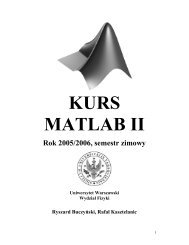
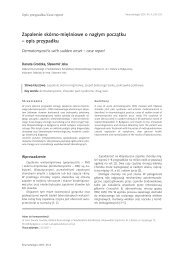
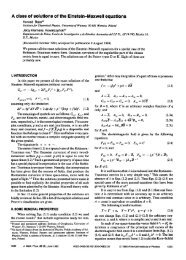
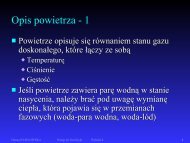
![slajdy [PDF, 0,6 MiB] - Instytut Geofizyki](https://img.yumpu.com/22546539/1/190x143/slajdy-pdf-06-mib-instytut-geofizyki.jpg?quality=85)
